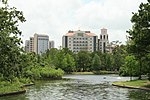The Texas Medical Center Library
The Texas Medical Center (TMC) Library is a health sciences library located in the Texas Medical Center (TMC) in Houston, TX. The TMC Library is the only major medical and scientific library serving the entire 1,345 sq. acre Texas Medical Center (TMC) campus and its non-profit institutions. It offers librarian services, and provides biomedical information for education and research activities to take place, and study space for students for these schools to help maintain their accreditation. Additionally, for the past twenty-five years, the TMC Library has been the home site for the National Network of Libraries of Medicine – South Central Region (NN/LM SCR). Through a competitive bid process, the TMC Library has secured the contract from the National Library of Medicine, under the National Institutes of Health.
Excerpt from the Wikipedia article The Texas Medical Center Library (License: CC BY-SA 3.0, Authors).The Texas Medical Center Library
John Freeman Boulevard, Houston
Geographical coordinates (GPS) Address Nearby Places Show on map
Geographical coordinates (GPS)
| Latitude | Longitude |
|---|---|
| N 29.712 ° | E -95.3967 ° |
Address
Jesse Jones Building
John Freeman Boulevard 1133
77030 Houston
Texas, United States
Open on Google Maps





